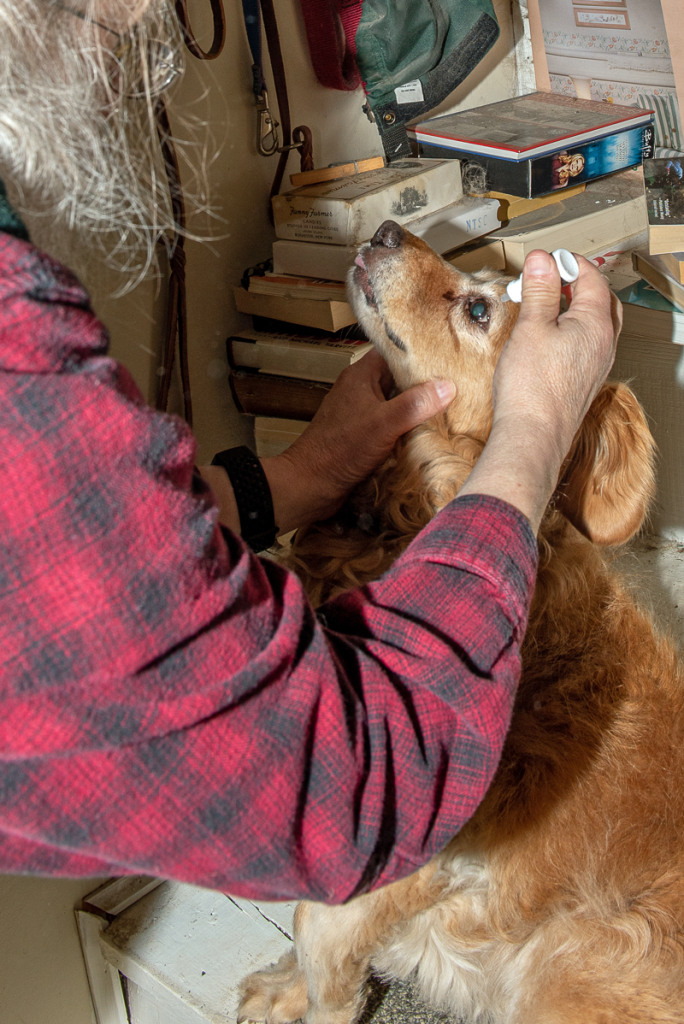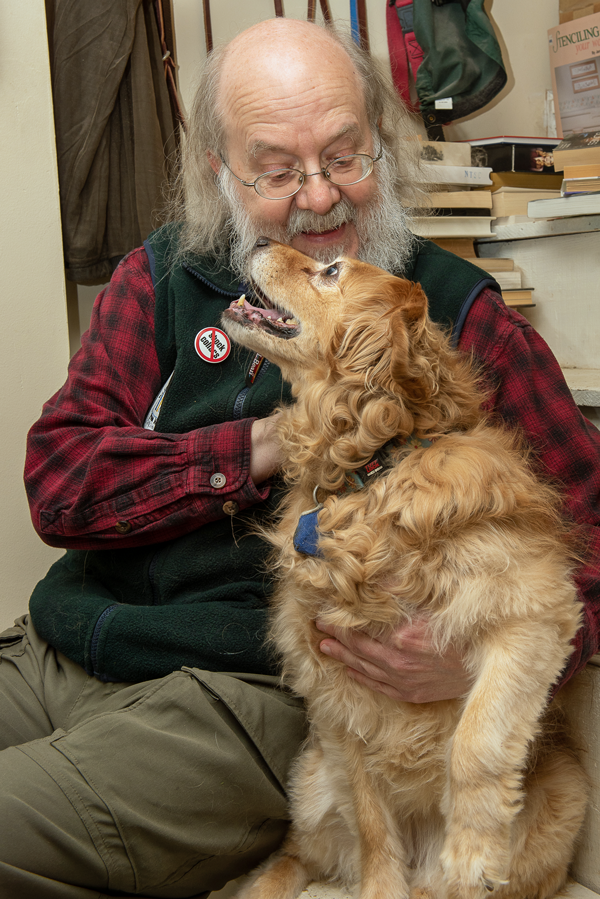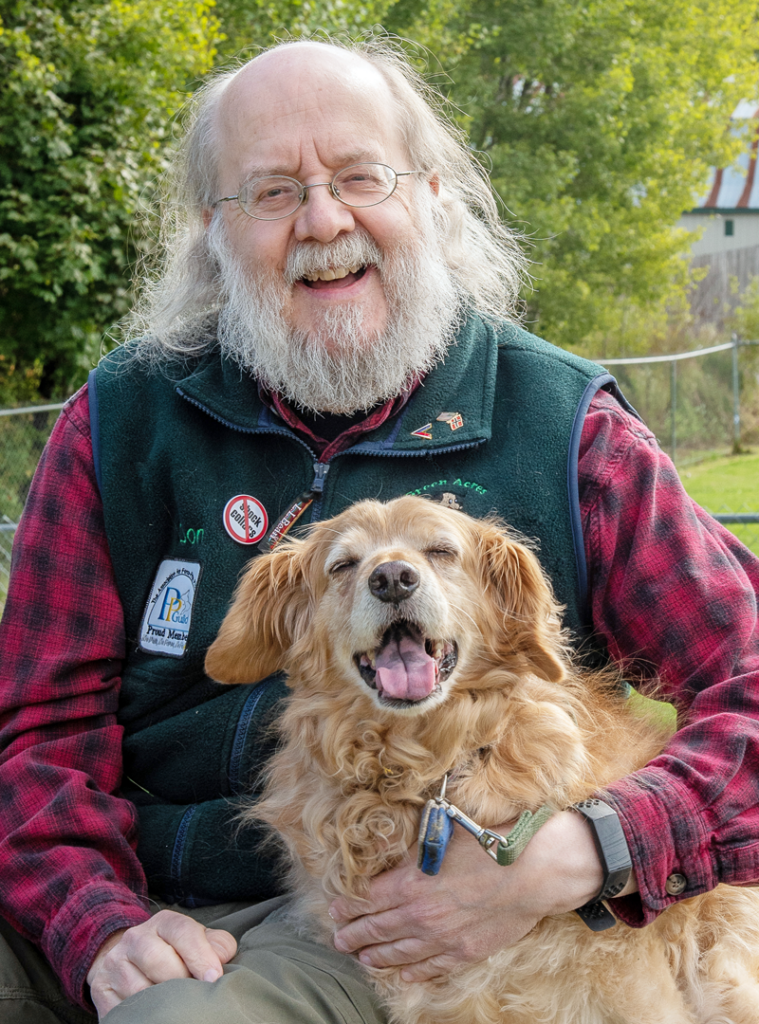Pets and Their People Blog
Eye Drops for Dogs, the Premack Principle, and Stationing on the Stairs
Students often ask me, “When can I stop training my dog.” That’s when I reply, “I never stop training.” By continuing to train, I keep my dog engaged, her life enriched, and my skills sharp.
For example, my continued training with Muppy helped me quickly address a new behavioral challenge related to her health.
Last spring Muppy was seen by an eye specialist and was prescribed eye drops that she requires every morning. Dr. Blackwood explained that one of the drops might sting and could cause Muppy to be less than cooperative. On day two, Muppy started hiding to avoid her drops. Since this would be a daily event, probably for the rest of her life, I was very concerned about how it could damage our bond.
The Premack Principle
If you go back to your childhood, you probably remember your mom telling you that you won’t get dessert if you don’t clean your plate. I remember an uncle who was going to take me fishing, telling me that I had to eat my bread crust before we could go down to the boat. Adults even use this tactic in their personal and business lives. When doing so, we are using a promise of a more desirable activity; eating dessert, as an incentive for completing a less desirable behavior; eating cooked spinach. We do this because it works! This behavior modification technique is called the Premack Principle.
Administering Eye Drops
My first step was to find a highly reinforcing behavior for Muppy that could be the reward for allowing me to administer her eye drops. One of Muppy’s greatest joys is mealtime. So this is how I incorporated the administration of Muppy’s eye drops into her morning routine. Each step follows the other.

(Photo by Debra Bell)
- Go outside for her morning bathroom break.
- Administer the eye drops.
- Breakfast!
I first started administering the eye drops in the kitchen close to the counter where I do Muppy’s food prep. She was on the floor, necessitating my bending over, something dogs find confrontational – and my back did not appreciate it either. Muppy also quickly learned that she could wiggle around the kitchen floor, making the process frustrating for both of us. She was getting her drops and breakfast, but it was still something she tried to avoid.
‘Drippy Drops’

(Photo by Debra Bell)
Then one day, I noticed something interesting. There was an intermediate step between coming in from outdoors and going into the kitchen to administer the drops. Muppy reliably defecates almost every morning. That means I return to the house with a full poop bag I need to take out to the poop receptacle. The door I go out is next to the stairs leading to the second floor. While I went out, Muppy would typically sit on the third step up from the floor and wait for me before we both went into the kitchen. That triggered an idea.
Trainers in zoos and other places with large captive animals train the animals in their care to “station” so they can perform necessary medical procedures. I saw this in action while attending an advanced animal training class at the Shedd Aquarium in Chicago. For example, Beluga Whales are trained to swim and remain on station in front of a target. At the same time, a veterinary technician draws blood from a flipper. At the end of the procedure, the whale was rewarded with a fish. So I decided to use the third step on the stairs as a station for Muppy’s eye drops.
This behavior now has a cue, ”Drippy Drops,” which I give to Muppy as I get rid of the poop bag. She sits on the step and waits until I’m back, about three seconds later. I have prepositioned the bottles of eye drops on another step, and Muppy is waiting for me on the third step. Since she is on the steps, she is less likely to squirm, and it’s easier for me to administer the drops quickly. Also, I do not need to bend as much because she’s elevated on the third step while I am standing on the floor.
“Drippy Drops” has become a routine behavior for us. I often do not need to give the verbal cue as Muppy automatically hops up on the third step, stations herself, and waits. She has learned that the drops mean she will get the meal she craves.
As our pets age, many may require medications regularly. Sometimes the medicine is a yummy treat, and our pets consume it without hesitation. However, as in Muppy’s case, her drops cause a little sting. The routine I’ve outlined here can be modified for several such situations. If you need help turning your pet’s medication into a positive experience, seek assistance from a qualified trainer.
About the Author
Don Hanson lives in Bangor, Maine, where he is the co-owner of the Green Acres Kennel Shop and the founder of ForceFreePets.com, an online educational resource for people with dogs and cats. He is a Professional Canine Behavior Consultant (PCBC-A) accredited by the Pet Professional Accreditation Board (PPAB) and a Bach Foundation Registered Animal Practitioner (BFRAP). Don is a member of the Pet Professional Guild (PPG), serving on the Board of Directors and Steering Committee and chairing the Advocacy Committee. He is also a founding director of Pet Advocacy International (PIAI). In addition, Don produces and co-hosts The Woof Meow Show podcast, available at http://bit.ly/WfMwPodcasts/, the Apple Podcast app, and Don’s blog: www.words-woofs-meows.com. The opinions in this post are those of Don Hanson.

©16-Nov-22, Donald J. Hanson, All Rights Reserved
< Click for Copyright and Use Policy >

